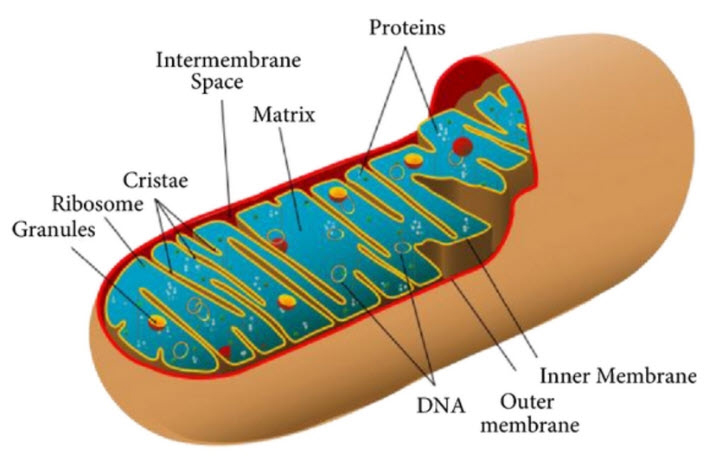Examining Your Mitochondrial Health

Want more energy?
Turn to your mitochondria!
Want to age more slowly?
Turn to your mitochondria!
Want to perform better?
Turn to your mitochondria!
Want to mend the damage you have caused to your body and brain?
Turn to your mitochondria!
Yes, that’s right, our mitochondria are the powerhouse of every cell in our body. It is the mitochondria that determine how your DNA is repaired. It is the mitochondria that produce energy in the form of ATP in the body. It is the mitochondria that we cannot live without. Preserving our mitochondria and optimizing their function is the true fountain of youth and life. I believe that attending to our mitochondrial health enhances hormone balance and response in women.
What is Mitochondria?
Mitochondria are organelles in our body that are actually descendants from bacteria. At some point in time, they found their way into the primordial eukaryotic cells and established a symbiotic relationship where they became the energy source of the body, while the body provides the organelle with substrate in which thrive and survive. The mitochondria takes the energy that we get from food and turns it into energy that the body cells can use to function. They have their own DNA and also help to secure the expression and replication of our body DNA. Science has discovered since the turn of the 21st century that substances pass from a cell to a mitochondria for activation or usage and this is the important interplay between these organisms and our body.
What Damages Mitochondria?
Chemicals, toxins, chemotherapy, parasites, genetic predispositions, and some infections can damage the mitochondria. In addition, oxidative stress can be a culprit as well. Even too much exercise can damage the mitochondria and this supports theories about excessive exercise contributing to aging.
Symptoms of Mitochondrial Damage or Dysfunction
As you can imagine, if the mitochondria get damaged, they cannot turn the energy from food into energy for cells to use. These cells will then get damaged. Common symptoms of mitochondrial dysfunction/damage are:
- Fatigue
- Muscle pain or poor recovery
- Memory loss
- Lack of muscle tone
- Dysfunction of any organ, liver, kidney, heart
- Diarrhea/constipation
- Thyroid issues/hormone imbalance
- Memory loss/cognitive impairment
- Learning disabilities
- Neurological symptoms
As you can see from the list, many systems in our body can be involved with mitochondrial dysfunction or damage.
Mitochondria and Hormones
Science has now discovered that it is in the mitochondria of the hormone secreting gland where hormone manufacturing is initiated! How does it happen? Tissues such as the ovaries, testis, adrenals, and brain can make steroid hormones. Estrogen, testosterone and progesterone all stem from cholesterol. Cholesterol from our diet goes into the bloodstream once our food is digested (or it may come from the liver where 80% of our cholesterol is made) and then enters a cell. Trophic (growth producing) hormones from the brain are produced and they go to their target steroid-producing-tissue such as the ovaries. At the tissue level different protein receptors are stimulated and inside the mitochondria steroid manufacturing begins, where cholesterol is converted into pregnenolone. The ability of cholesterol to move in and out of the mitochondria is the key step in making steroid hormones. Pregnenolone goes to the thecal cell where it turns into androstenedione. And then to the granulosa cell to be aromatized to estradiol.
Detecting Mitochondrial Damage
There are various tests in the mainstream that one can use to identify mitochondrial damage. These studies are typically reserved for those that have genetic disorders to mitochondrial function. Those who have true mitochondrial genetic disorders typically get diagnosed by age ten. However, there are mitochondrial disorders that are detected later in life such as Alzheimers, Lou Gherigs disease. Otherwise, taking careful family history, personal health history, environmental exposure, toxic metals testing, comprehensive blood testing, and even epigenetic testing can help to reveal if there is mitochondrial dysfunction happening.
Mitochondrial Repair
Recent studies have shown that mitochondria have repair mechanisms. However, with repeated insults, the mitochondria will be unable to repair itself. In addition, depending upon the duration and insult of injury to the mitochondria, it may take a long time to revive the mitochondria.
How You Can Repair Your Mitochondria
- Eat whole foods; organic, hormone free foods
- Intermittent fasting
- Exercise
- Prayer/meditation/relaxation/stress management
- Breathing exercises
- NAD
- CoQ10
- Resveratrol
- Selenium
- B Vitamins
- Vitamin C
- Melatonin
- Alpha lipoic acid
You may wonder, what is more important for prevention of aging, taking hormones or supporting mitochondria? In my opinion, both! Estrogen has been shown to prevent oxidative stress in the cell and support the manufacturing of ATP in the mitochondria. This research stemmed out of looking at the specific trends in Alzheimer’s disease and the fact that not only are women more prone to develop it, but also it occurs when estrogen levels decline! The same is true for heart attacks in postmenopausal females.
So, have your aging telomeres tested.
Take action to support your mitochondria.
If you have a health risk profile that supports the use of hormones then see your naturopathic doctor and get started!
References:
Image Credit:
TY – JOUR
AU – Petersen, Richard
PY – 2013/03/04
SP – 143589
T1 – Free-Radical Polymer Science Structural Cancer Model: A Review
VL – 2013
DO – 10.1155/2013/143589
JO – Scientifica

